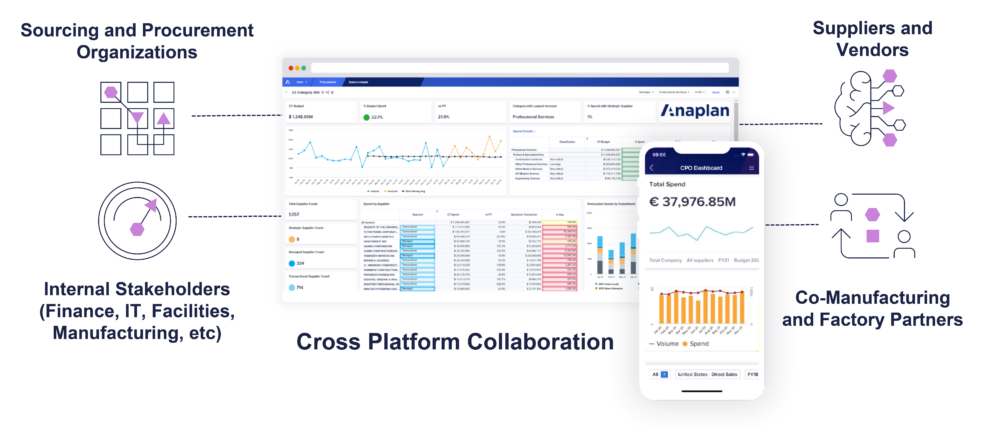Procurement planning platforms: Bring systems, stakeholders, and suppliers together in one collaborative environment


Procurement is sitting on a trove of untapped business value. Bring teams and systems together in a planning platform for a new competitive advantage.
Procurement doesn’t typically bask in the spotlight. It has always been the backstage gaffer of the show, making things run smoothly behind the scenes. Well, no longer. These days, thanks to serial disruption on a global scale, all eyes are on the supply chain. How can procurement restore predictability and resilience to badly destabilized systems?
Increasingly, the goal is not to weather uncertainty, but to adapt to it. Businesses are rightly focused on finding ways to embrace a less certain next normal, seizing the moment to fast-track new capabilities and accelerate modernization. Necessity is meeting transformative new technologies to deliver exciting results. Nowhere is this shift more promising than in procurement planning.
Procurement planning offers a uniquely rich and largely untapped opportunity to modernize for significant business gains. Many organizations have improved aspects of the procurement process, but the pieces remain disconnected. Procurement systems, often involving hundreds or even thousands of vendors, remain separate and opaque, both in terms of geography and function. A company might have a system for sourcing widgets in Australia, for example, but the EU team uses a different system and network of suppliers to manage their widget needs. Purchasing and engineering both buy widgets, too, but they use their own tools and systems, and even though they rely on some of the same vendors as the others, they don’t know it. When systems, teams, and suppliers are disconnected, it’s hard to recognize where potential operational efficiencies, cost savings, and risks might be hiding.
Procurement needs a unifying technology layer to bring it all together
Thanks to advances in cloud, data architecture, and system integration, it is now possible to bring any number of procurement systems, stakeholders, and partners seamlessly together in one unified platform. Powerful, cloud-native planning platforms that are purpose-built to enable collaboration, analysis, and scenario planning are opening up new sightlines on the business and revealing fresh opportunities to deliver value. Advanced planning platforms help organizations achieve three transformative goals:
1) Enable collaboration with internal teams and stakeholders
The right platform lets procurement engage more effectively with internal stakeholders, from finance and manufacturing to sales, marketing, and others across divisions and regions. When everyone has access to complete and up-to-date information on one platform, needs can be better understood and anticipated, and procurement can think strategically about how to meet those needs, leveraging their sourcing expertise. This creates opportunities for forward planning and analysis, an area where new business value can still be discovered.
At one technology company, procurement juggled more than 200 component suppliers globally. Implementing Anaplan Connected Planning made it possible to keep stakeholders throughout the company continuously informed of changes and updates. Having instant access to the latest information meant that teams could pivot earlier when circumstances changed and spot opportunities they might otherwise have missed.

2) Strengthen relationships with external partners
An advanced procurement planning platform can also securely connect external streams of data from suppliers, manufacturers, shippers, and other partners. Information flows both ways: When needs, capacities, or other factors change, everyone knows and can make adjustments immediately. The continuous flow of information between vendors and procurement helps both parties get to know each other better, raising awareness of capacities and opportunities as well as limitations and challenges. Vital in a crisis, this depth of knowledge also helps scale up production to support and drive growth.
When the business works more closely with partners, relationships are strengthened, enabling innovative thinking and improving resilience. Consider the example of one global consumer goods retailer that had just modernized its procurement function with Anaplan Connected Planning when a perfect storm of disruptions hit. They were able to quickly analyze a few scenarios, reallocate materials to a secondary manufacturing site, and keep production flowing. Without that central hub to unify internal and external players and data, it might have taken weeks instead of hours to devise a solution.
3) Replace spreadsheets with direct access to information
An effective platform further improves procurement planning by bringing together the systems various teams already use. The platform doesn’t replace existing solutions, it improves them by making their data readily available. Information flows directly into the platform where everyone can use it, eliminating the need to create spreadsheets to share and track data. Employees are freed from updating spreadsheets—and waiting for them to be updated.
This is a big win for planning. No matter how effective individual systems might be, when data is trapped and isolated, it’s hard to do spend analysis and sourcing planning. With everything in one place, forecasting can be based on current and complete numbers, improving accuracy. When things change, teams can explore “what-if” scenarios and their impact, making informed decisions quickly.
Given its complexity and many siloed components, procurement is ideally suited to benefit from a unifying platform. By modernizing the way procurement collaborates with stakeholders, interacts with vendors, and handles information, businesses can leapfrog forward to become more agile, efficient, innovative, and resilient.